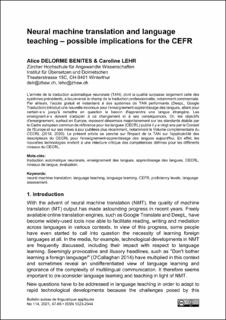Please use this identifier to cite or link to this item:
https://doi.org/10.21256/zhaw-24716| Publication type: | Article in scientific journal |
| Type of review: | Peer review (publication) |
| Title: | Neural machine translation and language teaching : possible implications for the CEFR |
| Authors: | Delorme Benites, Alice Lehr, Caroline |
| et. al: | No |
| DOI: | 10.5169/seals-1030137 10.21256/zhaw-24716 |
| Published in: | Bulletin suisse de linguistique appliquée |
| Volume(Issue): | 2021 |
| Issue: | 114 |
| Page(s): | 47 |
| Pages to: | 66 |
| Issue Date: | Apr-2022 |
| Publisher / Ed. Institution: | Vereinigung für Angewandte Linguistik in der Schweiz |
| ISSN: | 1023-2044 |
| Language: | English |
| Subjects: | Neural machine translation; Language teaching; Language learning; CEFR; Proficiency level; Language assessment; Traduction automatique neuronale; Enseignement des langues; Apprentissage des langues; CECRL; Niveau de langue; Evaluation |
| Subject (DDC): | 410.285: Computational linguistics 418.0071: Language teaching |
| Abstract: | L'arrivée de la traduction automatique neuronale (TAN), dont la qualité surpasse largement celle des systèmes précédents, a bouleversé le champ de la traduction professionnelle, notamment commerciale. Par ailleurs, l'accès gratuit et instantané à des systèmes de TAN performants (DeepL, Google Traduction) introduit une nouvelle inconnue pour l'enseignement-apprentissage des langues, allant pour certain·e·s jusqu'à remettre en question le besoin d'apprendre une langue étrangère. Les enseignant·e·s doivent s'adapter à ce changement et à ses conséquences. Or, les objectifs d'enseignement, surtout en Europe, reposent désormais majoritairement sur les standards établis par le Cadre européen commun de référence pour les langues (CECRL) publié il y a vingt ans par le Conseil de l'Europe et sur ses mises à jour publiées plus récemment, notamment le Volume complémentaire du CECRL (2018, 2020). Le présent article se penche sur l'impact de la TAN sur l'applicabilité des descripteurs du CECRL pour l'enseignement-apprentissage des langues aujourd'hui. En effet, les nouvelles technologies invitent à une relecture critique des compétences définies pour les différents niveaux du CECRL. The advent of neural machine translation (NMT), whose quality far surpasses that of previous systems, greatly changed the field of professional translation. Moreover, the free and instantaneous access to powerful NMT systems (DeepL, Google translate) raises new issues for language teaching and learning, and for some people it even calls into question the need to learn a foreign language. Teachers have to adapt to this change and its consequences. However, the teaching goals, especially in Europe, are now mainly based on the standards set by the Common European Framework of Reference for Languages (CEFR), published twenty years ago by the Council of of Europe and its more recent updates, including, the complementary volume of the CECRL (2018, 2020). This article investigates the impact of NMT on the applicability of the CEFR descriptors for language teaching and learning today, as new technologies require a critical re-reading of the competences defined for the different levels of the CEFR. |
| URI: | https://digitalcollection.zhaw.ch/handle/11475/24716 |
| Fulltext version: | Published version |
| License (according to publishing contract): | CC BY 4.0: Attribution 4.0 International |
| Restricted until: | 2022-10-01 |
| Departement: | Applied Linguistics |
| Organisational Unit: | Institute of Translation and Interpreting (IUED) |
| Published as part of the ZHAW project: | Digital Literacy im Hochschulkontext |
| Appears in collections: | Publikationen Angewandte Linguistik |
Files in This Item:
| File | Description | Size | Format | |
|---|---|---|---|---|
| 2022_DelormeBenites-Lehr_Neural-machine-translation-language-teaching.pdf | 5.06 MB | Adobe PDF |  View/Open |
Show full item record
Delorme Benites, A., & Lehr, C. (2022). Neural machine translation and language teaching : possible implications for the CEFR. Bulletin Suisse de Linguistique Appliquée, 2021(114), 47–66. https://doi.org/10.5169/seals-1030137
Delorme Benites, A. and Lehr, C. (2022) ‘Neural machine translation and language teaching : possible implications for the CEFR’, Bulletin suisse de linguistique appliquée, 2021(114), pp. 47–66. Available at: https://doi.org/10.5169/seals-1030137.
A. Delorme Benites and C. Lehr, “Neural machine translation and language teaching : possible implications for the CEFR,” Bulletin suisse de linguistique appliquée, vol. 2021, no. 114, pp. 47–66, Apr. 2022, doi: 10.5169/seals-1030137.
DELORME BENITES, Alice und Caroline LEHR, 2022. Neural machine translation and language teaching : possible implications for the CEFR. Bulletin suisse de linguistique appliquée. April 2022. Bd. 2021, Nr. 114, S. 47–66. DOI 10.5169/seals-1030137
Delorme Benites, Alice, and Caroline Lehr. 2022. “Neural Machine Translation and Language Teaching : Possible Implications for the CEFR.” Bulletin Suisse de Linguistique Appliquée 2021 (114): 47–66. https://doi.org/10.5169/seals-1030137.
Delorme Benites, Alice, and Caroline Lehr. “Neural Machine Translation and Language Teaching : Possible Implications for the CEFR.” Bulletin Suisse de Linguistique Appliquée, vol. 2021, no. 114, Apr. 2022, pp. 47–66, https://doi.org/10.5169/seals-1030137.
Items in DSpace are protected by copyright, with all rights reserved, unless otherwise indicated.